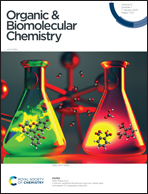Enhanced molecular binding affinity toward aromatic dications by anthracene-derived crown ethers in water†
Abstract
The pursuit of high molecular binding affinity using conventional crown ethers in water remains a challenging task in the field of supramolecular chemistry and may hold great promise in the creation of advanced biocompatible nanoconstructs. In this work, the molecular binding strength toward a series of structurally relevant cationic guests has been greatly enhanced by tetrasulfonated 1,5-dianthracenyl-42-crown-10 and as investigated by means of 1H NMR, UV–vis, and fluorescence spectroscopy, the host–guest association constants can reach up to 108 M−1 order of magnitude in aqueous solution. X-ray crystal diffraction analysis further demonstrates that the aromatic dication can be tightly encapsulated in the ring of anthracene-derived crown ether via multiple π-stacking and electrostatic interactions. Meanwhile, the obtained association constants are remarkably higher than the ones in the cases of the known benzene- and naphthalene-derived sulfonated crown ethers, substantiating that the appropriate extension of π-conjugation in the molecular skeleton of crown ether is a feasible method in attaining a highly affiliative host–guest complex. Taken together, our results indicate that the anthracene-based sulfonated crown ether can be developed as a new family of water-soluble macrocyclic receptors in the fabrication of functional nanoarchitectures.



 Please wait while we load your content...
Please wait while we load your content...